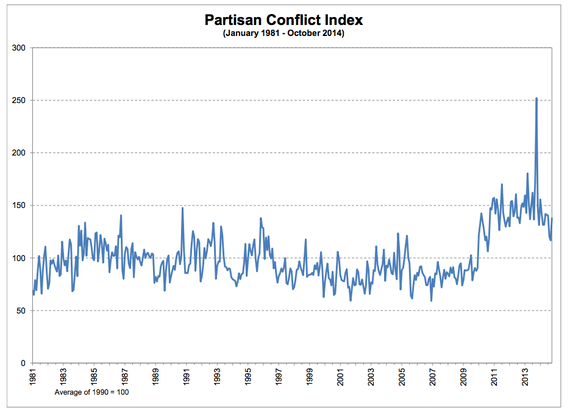An Incredibly Simple Way to Defuse Political Fights
Just hearing an ideological opponent make a minor concession creates significant differences in how people view them.
“It’s Official,” said the headline on a Bloomberg News article from last month, “Partisan Rancor Worst in Over a Century.”
The good news is that this headline is slightly misleading. According to the rancor index that the story cited—which is based on the frequency of newspaper reports of disagreement among federal politicians—peak rancor was actually reached last year, during the government shutdown. Still, if you look at the whole 33-year rancor graph , you will see that, by historical standards, things remain really rancorous.

Philadelphia Fed
But cheer up! There is now actual scientific evidence that points to a way to dampen the rancor—dampen it a little bit, at least.
The evidence grows out of a series of video debates that ran on this site earlier this year as part of a collaboration between The Atlantic and Bloggingheads.tv , which I run. The series, which was supported by the Democracy Fund , was called “The Good Fight.” The idea was to encourage the debaters to discuss not only what they disagreed about but what they agreed about. (I stole the idea from Mike Kinsley , who, back when he co-hosted CNN’s Crossfire , told me he wanted to start a show called Ceasefire that would focus on common ground.) The debates ran in full on Bloggingheads.tv, and The Atlantic ran a condensed version of each debate—a few short excerpts that highlighted disagreements, followed by a few excerpts that highlighted common ground.
And it turns out that, during the six months when the series aired on The Atlantic , the nation’s rancor index dropped! Just kidding. I mean, the rancor index does look like it may have dropped a bit around then, but that’s not the scientific evidence I’m talking about. The evidence I’m talking about comes from a study involving some of the Good Fight clips, conducted by a research group at Tufts University as part of the Democracy Fund project.
The question under study was what effect the “common ground” part of the debate had on viewers. To put a finer point on it: Suppose you’re a conservative or a liberal, and you’re watching a debate, and the debater you consider your ideological opponent throws in a “to be sure” sentence—a sentence that qualifies his or her basic policy position, underscoring some point of agreement with your ideological ally. Will that make you more favorably disposed to the person—more likely to take their views seriously, less likely to demonize them?
The study involved some 1,600 people, about half of whom identified themselves as liberal and half as conservative. Everyone watched an excerpt from one of two debates: one between Tim Noah and Glenn Loury on whether the minimum wage should increase, and one between Sarah Posner and Michael Dougherty on whether the government should be able to mandate that employer-provided health insurance cover contraceptives.
The excerpt shown to each viewer was short, but it clearly conveyed which person supported which position—in other words, who was the conservative and who was the liberal (on the issue in question, at least). For half of the viewers, the clip also included, at the end, a segment in which the speaker on the other side of the ideological fence from them added a to-be-sure.
So, for example, in the minimum-wage debate, half of the conservatives saw the minimum-wage advocate concede that there is such a thing as a minimum wage that’s too high, whereas the rest of the conservatives didn’t. And half of the liberals saw the speaker who opposed raising the minimum wage add that he wasn’t opposed to a minimum wage in principle—he just thought the minimum wage was already at least as high as it needed to be. The other half of the liberals saw no such concession.
The researchers at Tufts found that “viewing a concession created a more positive reaction to the ideological opponent.” Viewers who saw their ideological opponent make a concession were less likely than viewers who saw no concession to call their ideological ally the more credible of the two or the more knowledgeable of the two. And they were less likely to say they liked the ally more than the opponent.
People who saw the concession were also less likely to call their ideological ally the more persuasive of the two. But apparently the newfound persuasiveness of their ideological opponent didn’t translate very efficiently into actual persuasion. Though viewing a concession made people slightly more inclined to say they actually agreed with their ideological opponent, the difference wasn’t large enough to be very meaningful.
Then again, actually changing people’s minds wasn’t the object of the game. This exercise was about exploring ways to make political discourse in the U.S. slightly less toxic than it’s gotten. (And for what it’s worth: Watching a concession did make people more likely to say they understood the viewpoint of their ideological opponent, and were open to opinions expressed by the opponent. Whether this signaled actual openness and actual understanding is another question.)
To be sure (as we say in the rancor-dampening business), the changes in attitude weren’t huge. Seeing a concession reduced the likelihood of deeming your ideological ally the more credible from 51 percent to 45 percent; the more knowledgeable from 43 to 35 percent; and the more likeable from 45 to 39 percent.
On the other hand, changes of even that magnitude are kind of impressive given that the “concessions” weren’t generally all that magnanimous. Shouldn’t it go without saying that a liberal would concede that some minimum wage—say $40,000 per hour—would be too high? And it’s not all that shocking when a conservative concedes that, yes, there should be some floor—somewhere above zero cents per hour—under wages. (The to-be-sures in the contraception debate were perhaps slightly more significant, but ultimately pretty vague. The liberal conceded that the government “should be mindful of people’s religious exercise and take steps to ensure that it’s not infringed upon.” The conservative conceded that contraception should be “not just available but accessible.”)
So, in a way, the question isn’t why the to-be-sures didn’t have more impact, but why they had as much impact as they had.
I have a theory. One rancor-exacerbating psychological tendency, I’ve always thought, is that people are naturally inclined to caricature their ideological opponents. So, for example, doves see hawks as bloodthirsty warmongers, hawks see doves as weak-kneed appeasers. It doesn’t take a very dramatic “to-be-sure” to make at least a modest dent in a stereotype that’s so extreme in the first place. (“To be sure, there are countries I don’t favor bombing …”) That would explain why even the modest to-be-sures that were part of this study moved the dial appreciably.
As is often the case with social-science findings, some people will react to this by saying, “So what?” Granted that we now have actual evidence of the power of to-be-sures, what are we supposed to do with that knowledge?
I can imagine a couple of things.
First, a message to people on the left and right who opine in public: Don’t forget to throw in a to-be-sure sentence; it may sound like a “concession,” but it could wind up helping your cause, especially if your cause includes not seeing America consumed by bitter acrimony. And it’s especially advisable to do this when you’re in “enemy territory”—when liberals are on Fox News, when conservatives are on MSNBC.
Second, it would be nice if the formats that mediate our discourse made it practical to add a to-be-sure sentence. For example, a pet crusade of mine is to change the structure of Twitter in a way that, while maintaining the 140-character limit on tweets, would nonetheless make it easier to add a short elaboration.
I also have a third suggestion: In at least some debates, “moderators” should play a less prominent role, or maybe no role at all. This may sound ironic. If our goal is to exert a moderating influence, what could come in handier than a moderator? And this suggestion may not bear any obvious relationship to the things that, in this study, helped mitigate partisan bias.
But there is a relationship between this suggestion and the fact that the bias wasn’t higher in the first place. After all, you can imagine things being so rancorous that something much closer to 100 percent of the viewers who saw no concession would have found their ally more credible, knowledgeable, and likeable than their opponent. But instead that number tended to come in at around 50 percent, if not lower; a large chunk of people (respectively, 37, 43, and 49 percent) favored neither debater in these departments, and a smaller chunk favored the ideological opponent.
I have a theory about why the default bias in favor of allies wasn’t higher. The Bloggingheads.tv format isn’t like what you’d see on, say, the PBS NewsHour , where they put together two people who disagree, and then a moderator asks them questions. In that format the two people never talk directly to each other, but, rather, reply to the moderator. On BhTV there’s usually no moderator, so it’s a direct, unmediated exchange—a conversation. And one thing I’ve noticed since we started doing these dialogues nine years ago is that when people who disagree with each other have an unmediated dialogue, they are almost always very civil.
This holds even for people who have been pretty snide when writing about each other’s views. Apparently direct, unmediated dialogue tends to trigger some sort of civilizing machinery in the brain. In fact, we’ve found this to be a bit of a problem. Ideological opponents are sometimes so intent on staying friendly that they’re reluctant to delve deeply into their differences. And “let’s just agree to disagree on that one” isn’t very riveting TV.
I suspect that there is a spillover effect here—that the very sight of your ideological ally and an ideological opponent respectfully engaging one another reduces your tendency to demonize the opponent. And that’s what viewers saw in this study whether or not they saw the concession clip. If there’s a moderator, in contrast, you may see both debaters being civil, but you won’t see your ideological ally being civil toward your ideological opponent. So you won’t be getting cues from your “team” that the other team is worthy of respect. (The unedited debates in this series did, in a departure from BhTV tradition, feature a moderator, but one who wasn’t onscreen and was so non-interventionist that the debaters just spoke directly to each other; the moderator wasn’t featured in the clips used on The Atlantic or in the study.)
So maybe what we need is less in the way of formal, moderated debate and more in the way of direct conversation. Of course, to be punchy and concise enough to attract many viewers, the dialogue would have to be edited, conversation being the meandering thing that it is. Still, it might be worth the trouble, because it could indeed be the case that moderators are ultimately not conducive to moderation. But that’s a question for another study.
( Top image via Johan Swanepoel / Shutterstock.com )



